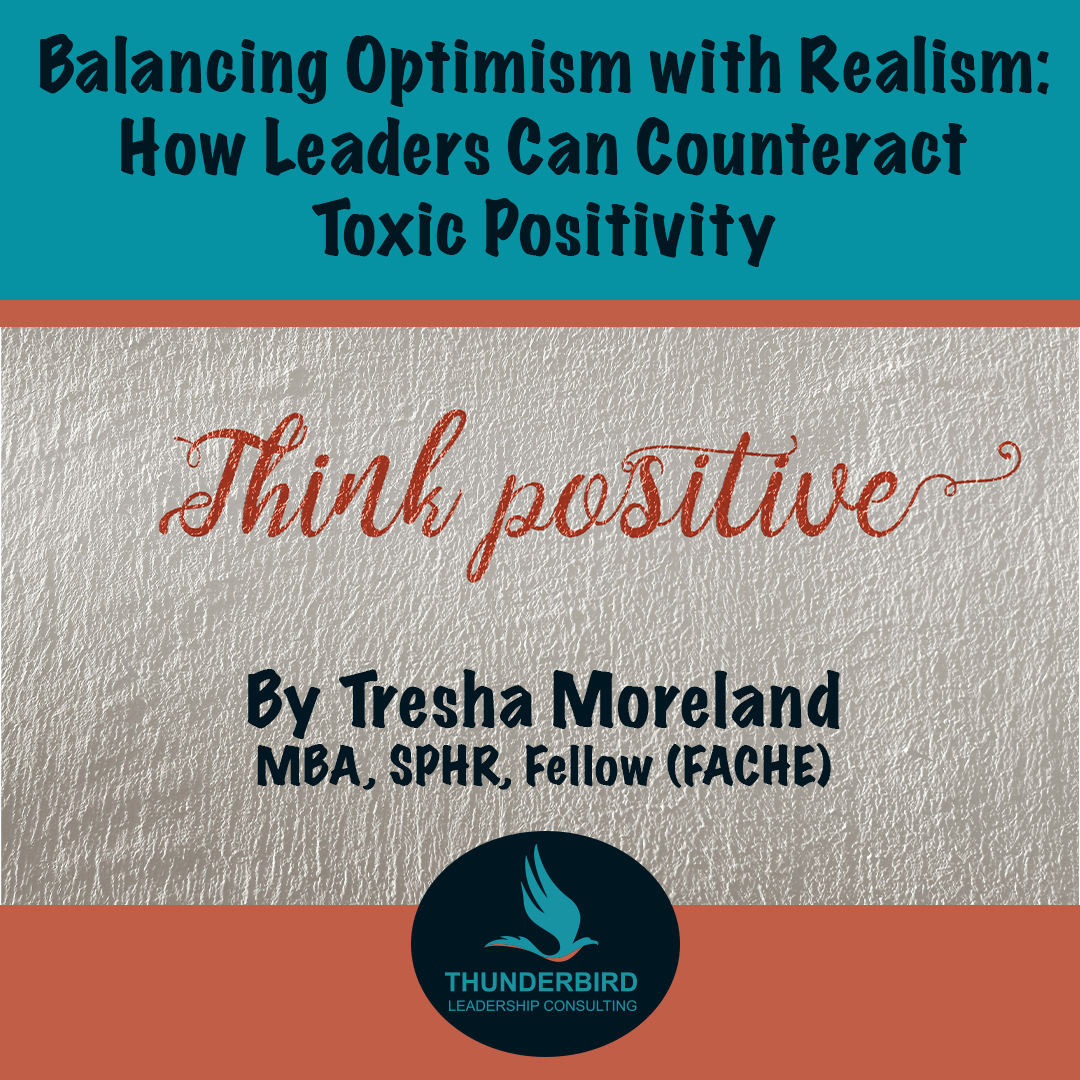Balancing Optimism with Realism: How Leaders Can Counteract Toxic Positivity

By Tresha Moreland, MBA, SPHR, Fellow (FACHE)
In the modern workplace, leaders often emphasize the importance of staying positive, especially when navigating tough times. However, when optimism becomes excessive and dismisses legitimate concerns, it turns into toxic positivity—or “glossing.”
Glossing is the tendency to mask challenges with relentless positivity, creating an environment where employees feel unheard and their struggles minimized. Leaders who recognize and address this tendency can foster trust, empathy, and open communication.
Understanding Toxic Positivity
Toxic positivity is the compulsion to react to distress with superficial assurances, such as “Everything will be fine” or “Look on the bright side,” without acknowledging the real challenges at hand. While a positive outlook can motivate, consistently brushing over problems stifles open dialogue and invalidates emotions. The result? Teams may feel pressured to hide concerns or adopt a “just keep smiling” attitude, which erodes trust and authenticity.
Leaders must balance optimism and realism to create a supportive, truthful, and productive environment.
Why Glossing Is Detrimental to Trust and Team Dynamics
Glossing can erode trust and team cohesion in subtle but damaging ways:
- It suppresses open communication: When leaders ignore or downplay difficulties, employees may feel discouraged from voicing concerns or offering feedback. This can create a culture of silence where critical problems are overlooked until they escalate.
- It fosters disconnection: Employees must feel that their leaders understand and empathize with their experiences. By glossing over challenges, leaders risk appearing out of touch or insincere, damaging their credibility.
- It undermines problem-solving: Productive teams thrive on tackling problems head-on. Toxic positivity prevents teams from discussing obstacles and finding real solutions, ultimately hindering growth.
Practical Strategies for Leaders to Avoid Glossing
Recognizing tendencies toward glossing is only the first step. Leaders need actionable strategies to maintain a healthy balance between optimism and realism. Here are some practical approaches:
1. Embrace Transparent Communication
Transparency is the antidote to glossing. Leaders should be clear and upfront about challenges without being defeatist. For example, during periods of organizational change, it’s more effective to say, “We’re facing a difficult transition period, but I’m confident we have the resilience to navigate it,” than to say, “Don’t worry; it’s all going to be perfect.”
Practical Tip: Share facts and context. Discuss what’s going well and acknowledge what isn’t. This builds a culture where employees know they’re getting the full picture and can trust leadership to be honest.
2. Encourage Empathetic Leadership
Empathy allows leaders to connect with their teams on a deeper level. When employees feel understood, they’re more likely to engage openly. Empathetic leadership means acknowledging stressors, asking questions, and listening without judgment.
Practical Tip: Practice active listening during meetings and one-on-ones. Instead of moving quickly to solutions, pause to acknowledge what’s being shared. Phrases like “I hear you” or “That sounds challenging” can create a safe space for honest communication.
3. Create a “Safe-to-Speak” Environment
One of the best ways to counter toxic positivity is to clarify that constructive criticism and honest discussions are valued. Employees should feel safe sharing their concerns without fear of reprimand or dismissal.
Practical Tip: Establish regular feedback sessions where teams can discuss both wins and challenges. Implement open-door policies that encourage employees to voice their thoughts outside structured meetings.
Balancing Positivity with Realism
Optimism can still play a significant role in leadership—when used correctly. Positive reinforcement motivates teams and helps maintain morale. The key is to balance optimism with realistic acknowledgment of the current situation.
How to Balance:
- Acknowledge the struggle and celebrate efforts: “I know this project has had its difficulties, but I want to recognize the effort everyone’s put in. We’ve overcome some major hurdles, and I believe we can keep pushing forward.”
- Model vulnerability: It’s okay for leaders to share that they don’t have all the answers. Saying, “This is tough, and I’m still figuring out the best path forward,” can make leaders more relatable and inspire confidence.
The Long-Term Benefits of Avoiding Glossing
By counteracting toxic positivity, leaders foster a work culture that prioritizes transparency, empathy, and trust. This, in turn, creates:
- Stronger team morale: When employees know they can be honest without repercussions, morale improves. They feel valued and seen, which boosts overall job satisfaction.
- Better problem-solving: Transparent dialogue allows teams to identify challenges early and develop solutions collaboratively.
- Sustained resilience: Teams that face challenges head-on are better prepared for future uncertainties. They develop resilience by learning to adapt, pivot, and support each other through change.
Wrapping it Up
Leaders don’t need to choose between positivity and realism—both can coexist in a healthy balance. By recognizing and counteracting glossing tendencies, leaders build trust and foster an environment where open dialogue thrives. The result is a workplace where employees feel empowered, engaged, and equipped to navigate challenges together.
